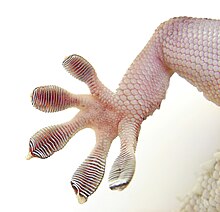Lamella (surface anatomy)
 From Wikipedia - Reading time: 5 min
From Wikipedia - Reading time: 5 min
This article includes a list of general references, but it lacks sufficient corresponding inline citations. (February 2012) |

In surface anatomy, a lamella is a thin plate-like structure, often one amongst many lamellae very close to one another, with open space between. Aside from respiratory organs, they appear in other biological roles including filter feeding and the traction surfaces of geckos.[1]

In fish, gill lamellae are used to increase the surface area in contact with the environment to maximize gas exchange (both to attain oxygen and to expel carbon dioxide) between the water and the blood.[3] In fish gills, there are two types of lamellae, primary and secondary. The primary gill lamellae (also called gill filament) extends from the gill arch, and the secondary gill lamellae extends from the primary gill lamellae. Gas exchange primarily occurs at the secondary gill lamellae, where the tissue is notably only one cell layer thick. Furthermore, countercurrent gas exchange at the secondary gill lamellae further maximizes oxygen uptake and carbon dioxide release.
See also
[edit]- Pecten (biology) – the similar structure in birds
References
[edit]- ^ Big bertha needs some milk
Santos, Daniel; Matthew Spenko; Aaron Parness; Kim Sangbae; Mark Cutkosky (2007). "Directional adhesion for climbing: Theoretical and practical considerations". Journal of Adhesion Science and Technology. 21 (12–13): 1317–1341. doi:10.1163/156856107782328399. S2CID 53470787.
Gecko "feet and toes are a hierarchical system of complex structures consisting of lamellae, setae, and spatulae. The distinguishing characteristics of the gecko adhesion system have been described [as] (1) anisotropic attachment, (2) high pull-off force to preload ratio, (3) low detachment force, (4) material independence, (5) self-cleaning, (6) anti-self sticking and (7) non-sticky default state. ... The gecko's adhesive structures are made from ß-keratin (modulus of elasticity [approx.] 2 GPa). Such a stiff material is not inherently sticky; however, because of the gecko adhesive's hierarchical nature and extremely small distal features (spatulae are [approx.] 200 nm in size), the gecko's foot is able to intimately conform to the surface and generate significant attraction using van der Waals forces.
- ^ Kwan, Garfield T.; Wexler, Jeanne B.; Wegner, Nicholas C.; Tresguerres, Martin (February 2019). "Ontogenetic changes in cutaneous and branchial ionocytes and morphology in yellowfin tuna (Thunnus albacares) larvae". Journal of Comparative Physiology B. 189 (1): 81–95. doi:10.1007/s00360-018-1187-9. ISSN 0174-1578. PMID 30357584. S2CID 53025702.
- ^ Evans, David H.; Piermarini, Peter M.; Choe, Keith P. (January 2005). "The Multifunctional Fish Gill: Dominant Site of Gas Exchange, Osmoregulation, Acid-Base Regulation, and Excretion of Nitrogenous Waste". Physiological Reviews. 85 (1): 97–177. doi:10.1152/physrev.00050.2003. ISSN 0031-9333. PMID 15618479.
 KSF
KSF